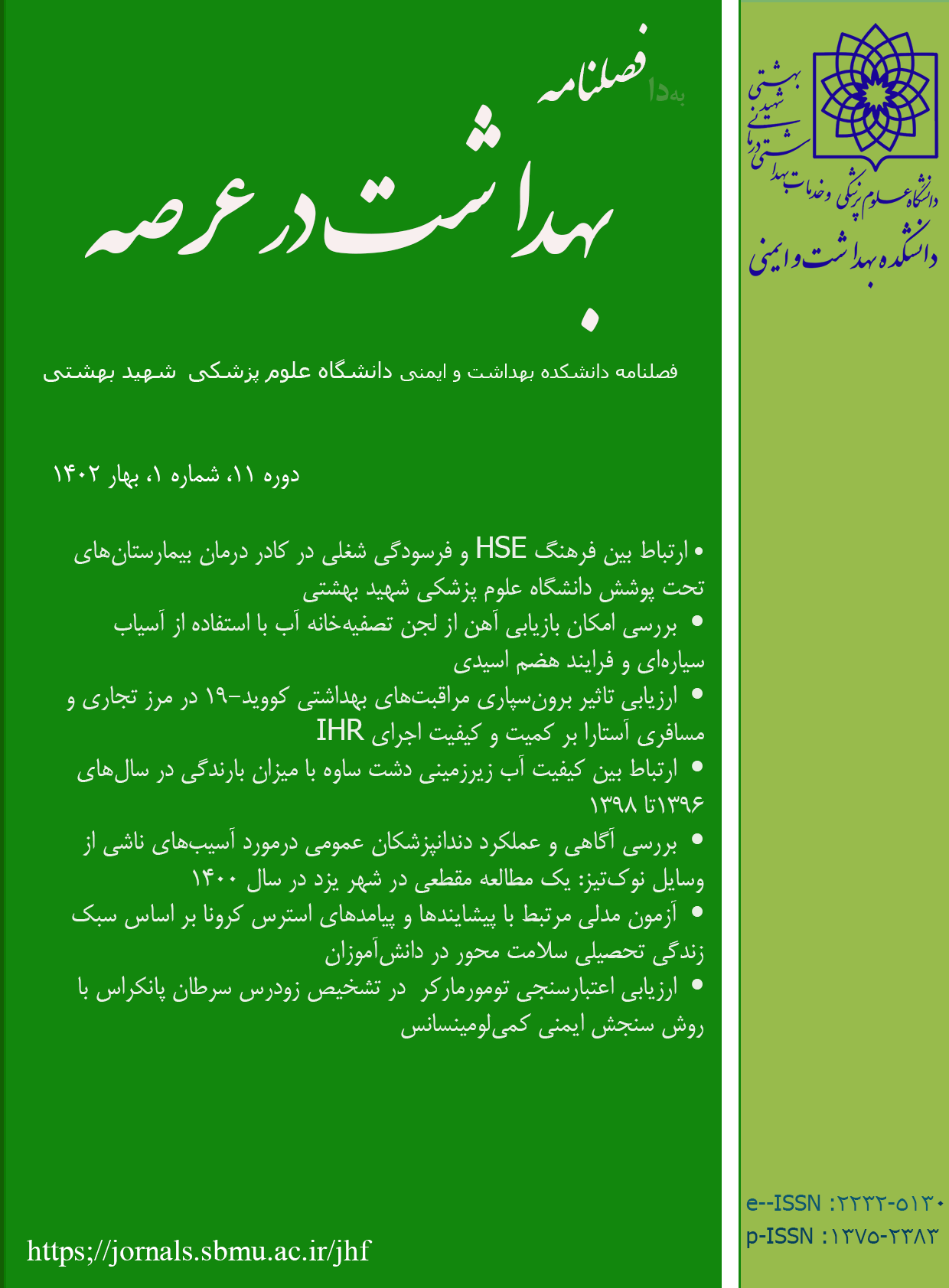بررسی کارایی انعقاد الکتریکی در تصفیه شیرابه پسماندهای شهری
فصلنامه علمی پژوهشی بهداشت در عرصه,
دوره 4 شماره 1,
20 March 2016
,
صفحه 32-38
https://doi.org/10.22037/jhf.v4i1.12024
چکیده
زمینه و هدف: با توجه به آلودگی بالای شیرابه محل دفن و جهت جلوگیری از آلودگی محیط زیست، این مطالعه با هدف بررسی تعیین تاثیر فرایند انعقاد الکتریکی در حذف مواد آلی، نیتروژن، فسفر و کدورت، طراحی و اجرا شد.
مواد و روش ها: مطالعه حاضر یک مطالعه توصیفی تحلیلی با رویکرد تجربی و آزمایشگاهی بود. از شیرابه تولیدی در مرکز دفن و کمپوست شهر گرگان نمونه گرفته شد و وارد راکتور الکتروکواگولاسیون شد. در شراط مختلف عملکردي، زمان ماند20، 40 و 60 دقیقه، pH برابر 3 ، 6 و 9 و اختلاف پتانسیل الکتریکي20، 40 و 60 ولت، از شیرابه داخل راکتور نمونه برداری شد و طبق روش استاندارد پارامترهای مورد مطالعه اندازه گیری شد. این طرح پژوهشی با توجه به ماهیت آن منافاتی با مسائل اخلاقی نداشت.
یافته ها: بیشترین میزان حذف در میزان ولتاژ 60 ولت، زمان 60 دقیقه و pH برابر حدود خنثی (6.9-6.5) بود. میزان حذف کدورت، ،COD نیترات و فسفر در شیرابه خام به ترتیب برابر 59/14، 44/33، 40/81و 48/86درصد بود. این مقادیر برای پساب خروجی تصفیه خانه که تحت راکتور انعقاد الکتریکی قرار گرفته بود به ترتیب برابر 88/9، 80/5، 59/16و 62/35درصد بود.
نتیجه گیری: فرایند انعقاد الکتریکی به عنوان فرایند پیش تصفیه، باعث حذف مواد آلی، کدورت، مواد مغذی، کاهش بار آلی و افزایش تجزیه پذیری شیرابه می گردد و میتواند به عنوان گزینهای موثر جهت پیش تصفیه موثر فاضلاب، جلوگیری از آلودگی محیط زیست، منابع آب و حفاظت از آنها مدنظر قرار گیرد
- شیرابه، نیترات، فسفر، الکتروکواگولاسیون، اکسیژن مورد نیاز شیمیایی
ارجاع به مقاله
مراجع
Cho SP, Hong SC, Hong SI. Study of the end point of photocatalytic degradation of landfill leachate containing
refractory matter. Chemical Engineering Journal 2004; 98(3):245-53.
Tizaoui C, Bouselmi L, Mansouri L, Ghrabi A. Landfill leachate treatment with ozone and ozone/hydrogen
peroxide systems. Journal of Hazardous Materials 2007; 140(1):316-24.
Kurniawan TA, Lo W, Chan GYS. Radicals-catalyzed oxidation reactions for degradation of recalcitrant
compounds from landfill leachate. Chemical Engineering Journal 2006; 125(1):35-57.
Omranimanesh R, Karimijashni A. Treatment of municipal solid waste leachate by coagulation-flocculation.
Proceedings of the 4th National Congress of Civil Engineering 2008 May. 6-8; Tehran, Iran (In Persian).
Deng Y, Englehardt JD. Electrochemical oxidation for landfill leachate treatment. Waste Management 2007;
(3):380-88.
Ovaisi D, Saboor MR, Hosseini M. Performance anaerobic reactors UASB for treatment of Tehran Kahrizak
landfill leachate. Proceedings of the 9th National Congress of Iranian Environmental Health 2006 Oct. 28-30;
Esfahan, Iran (In Persian).
Halajnia A, Oustan S, Najafi N, Khataee A, Lakzian A. The adsorption characteristics of nitrate on Mg–Fe and
Mg–Al layered double hydroxides in a simulated soil solution. Applied Clay Science 2012; 70:28-36.
Ganesan P, Kamaraj R, Vasudevan S. Application of isotherm, kinetic and thermodynamic models for the
adsorption of nitrate ions on graphene from aqueous solution. Journal of the Taiwan Institute of Chemical Engineers
; 44(5):808-14.
Cho D-W, Chon C-M, Kim Y, Jeon B-H, Schwartz FW, Lee E-S, et al. Adsorption of nitrate and Cr (VI) by
cationic polymer-modified granular activated carbon. Chemical Engineering Journal 2011; 175:298-305.
Islam M, Patel R. Physicochemical characterization and adsorption behavior of Ca/Al chloride hydrotalcite-like
compound towards removal of nitrate. Journal of Hazardous Materials 2011; 190(1):659-68.
Metcalf & Eddy. Wastewater Engineering Treatment and Reuse. 4th ed. New York: McGraw-Hill 2003; P: 60-
Bitton G. Wastewater Microbiology. 3rd ed. New Jersey: John Wiley & Sons 2005; P:20-100
Rezaie E, Sadeghi M, Shams Khoramabadi Gh. A Study on the leachate treatment by using electrochemical
process. Journal of Research in Environmental Health 2015; 1(4):297-305 (In Persian).
Mollah MY, Morkovsky P, Gomes JA, Kesmez M, Parga J, Cocke DL. Fundamentals, present and future
perspectives of electrocoagulation. Journal of Hazardous Materials 2004; 114(1):199-210.
Holt PK, Barton GW, Mitchell CA. The future for electrocoagulation as a localised water treatment technology.
Chemosphere 2005; 59(3):355-67.
Janssen L, Koene L. The role of electrochemistry and electrochemical technology in environmental protection.
Chemical Engineering Journal 2002; 85(2):137-46.
Koparal AS, Öğütveren ÜB. Removal of nitrate from water by electroreduction and electrocoagulation. Journal
of Hazardous Materials 2002; 89(1):83-94.
Lin C-J, Lo S-L, Kuo C-Y, Wu C-H. Pilot-scale electrocoagulation with bipolar aluminum electrodes for on-site
domestic greywater reuse. Journal of Environmental Engineering 2005; 131(3):491-95.
Cabeza A, Urtiaga A, Rivero M-J, Ortiz I. Ammonium removal from landfill leachate by anodic oxidation.
Journal of Hazardous Materials 2007; 144(3):715-19.
APHA, AWWA, WEF. Standard Methods for the Examination of Water and Wastewater. 21st ed. Washington
DC: American Public Health Association 2005; Part1000-3000.
Kobya M, Can OT, Bayramoglu M. Treatment of textile wastewaters by electrocoagulation using iron and
aluminum electrodes. Journal of Hazardous Materials 2003; 100(1):163-78.
Chen X, Chen G, Yue PL. Separation of pollutants from restaurant wastewater by electrocoagulation. Separation
and Purification Technology 2000; 19(1):65-76.
Vik EA, Carlson DA, Eikum AS, Gjessing ET. Electrocoagulation of potable water. Water Research 1984;
(11):1355-60.
Al-Anbari RH, Albaidani J, Alfatlawi SM, Al-Hamdani TA. Removal of Heavy Metals from Industrial Water
Using Electro-Coagulation Technique. Proceedings of the Twelft International Water Technology Conference 2008
Dec. 18-21; Alexandria, Egypt; pp. 355-71.
Mahvi AH, Bazrafshan E. Removal of cadmium from industrial effluents by electrocoagulation process using
aluminum electrodes. World Applied Sciences Journal 2007; 2(1):34-39.
Mahvi AH, Ebrahimi SJA-d, Mesdaghinia A, Gharibi H, Sowlat MH. Performance evaluation of a continuous
bipolar electrocoagulation/electrooxidation–electroflotation (ECEO–EF) reactor designed for simultaneous removal
of ammonia and phosphate from wastewater effluent. Journal of Hazardous Materials 2011; 192(3):1267-74.
- چکیده مشاهده شده: 574 بار
- PDF دانلود شده: 202 بار
